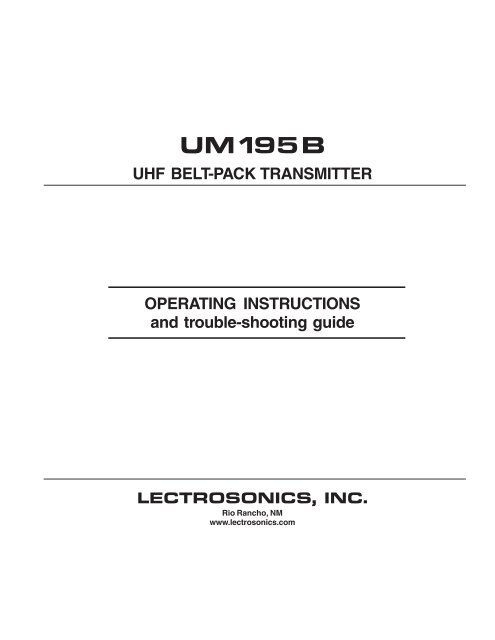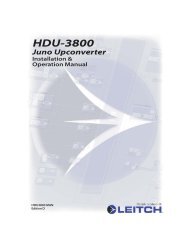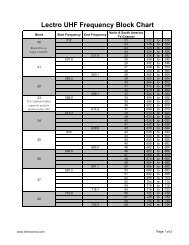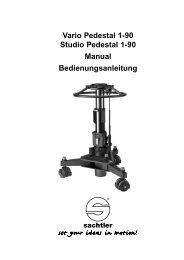UM195 UHF Belt Pack Transmitter Operating ... - All Mobile Video
UM195 UHF Belt Pack Transmitter Operating ... - All Mobile Video
UM195 UHF Belt Pack Transmitter Operating ... - All Mobile Video
- No tags were found...
You also want an ePaper? Increase the reach of your titles
YUMPU automatically turns print PDFs into web optimized ePapers that Google loves.
<strong>UM195</strong>B<strong>UHF</strong> BELT-PACK TRANSMITTEROPERATING INSTRUCTIONSand trouble-shooting guideLECTROSONICS, INC.Rio Rancho, NMwww.lectrosonics.com
<strong>UM195</strong>BCONTROLS AND FUNCTIONSLECTROSONICS<strong>UM195</strong>BOFF ONAUDIOLEVELANTENNA0–20LFROLL-OFFAdjustment75 Hz35 150LF ROLL OFFFCC ID: DBZ<strong>UM195</strong>Lectrosonics, Inc.Made in U.S.A.SN:XXXXINPUT JACKThe 5-pin input jack accommodates virtually every lavalier, hand-held or shotgun microphone available. Use aSwitchcraft TA5F connector on the cord. See the separate sheet titled “<strong>Transmitter</strong> 5-Pin Input Jack Wiring” regardingthe correct connections for various microphones, and other sources.ON/OFF SWITCHTurns the battery power on and off.“ON” LAMPGlows brightly when the battery is good. A weak or dim lamp means that the battery is weak, and has about half anhour of operation left. If the lamp fails to light, the battery should be replaced.The “ON” lamp is connected to a precision battery test circuit that continuously monitors battery voltage. The LED isat full brightness with a new 9 Volt battery. As the battery voltage drops during use, the LED brightness will alsodecrease. When the LED is barely visible, there will still be 30 minutes or more operating time remaining.Since the internal circuits are all tightly regulated and the RF output stage has a separate discrete regulator, thetransmitter will continue to operate to a battery voltage of 6.5 Volts. From 6.5 Volts to 6 Volts, the transmitter will stilloperate, but with degraded performance. Please note that a weak battery will sometimes light the POWER LEDimmediately after turn on, but will soon discharge to the point where the LED will go out, just like a flashlight with“dead” batteries.The combination of an accurate battery condition indicator and regulation of all internal circuits provides much longerbattery life, as well as consistent performance over the life of the battery.4LECTROSONICS, INC.
<strong>UHF</strong> <strong>Belt</strong>-<strong>Pack</strong> <strong>Transmitter</strong>MODULATION LEDSIndicate the proper setting of the MIC LEVEL control.LEVEL LED -- Flickers or glows when sufficient audio is present.LIMIT LED -- Lights up when the input level is high enough to cause limiting. The input limiter has a very highoverload threshold (over 30 dB). Generally speaking, some limiting is desirable in normal operation to improvethe signal to noise ratio of the system. The limiting action is not audible and does not create distortion. A highlytrained ear would hear only the compression of the peaks in the audio signal, which is desirable with most taperecorders and many sound reinforcement systems.MIC LEVELUsed to adjust the audio input level for the proper modulation.ANTENNA JACKThe flexible wire antenna supplied with the transmitter is cut to 1/4 wavelength. It is removable via an SMA connector.The 50 Ohm RF port can also be connected directly to test equipment.ADJUSTABLE LOW FREQUENCY ROLL-OFFA 18dB per octave low frequency roll-off is provided in the audio section, with the -3dB point adjustable from 35Hz to150Hz. The actual roll-off frequency will vary somewhat according to the low frequency response of the mic capsulebeing used.The low frequency roll-off control is used to prevent undesirable subsonic (or very low frequency) audio, often producedby air conditioning systems, automobile traffic and other sources from causing the compandor to mistrack.Excessive low frequency content in the audio input can cause “pumping and breathing” of background noise ormodulation of the program audio in recording applications. In sound reinforcement systems, excessive low frequencycontent can cause excessive power amplifier drain or even damage to loudspeaker systems. By rotating the controlclockwise, the hinge point of the roll-off is increased to reduce the level of low frequencies. In controlled situations,such as a motion picture production set indoors where environmental noise is minimal, the control can be rotatedcounter-clockwise to permit low frequency audio to be captured.THE BELT CLIPThe belt clip may be removed for special applications by removing one screw.USE ONLY THE SCREW THAT IS SUPPLIEDThe circuitry is tightly packed into this unit. A longer screw will permanently damage the transmitter!Rio Rancho, NM – USA5
<strong>UM195</strong>BBATTERY INSTALLATIONThe transmitter is powered by a 9 Volt alkaline or lithium battery. It is important that you use ONLY an ALKALINE orLITHIUM battery for longest life. Standard zinc-carbon batteries marked “heavy-duty” or “long-lasting” are not adequate.Ni-cad rechargeable batteries will only provide 2 hours of operation, or less, and will run down quite abruptly.The battery status circuitry is designed for the voltage drop over the life of alkaline batteries.To open the battery compartment, press outward on the cover door in the direction of the arrow as shown in thedrawing. Only firm, sliding pressure is needed to open and close the battery door. Swing the door open and takenote of the polarity marked inside showing the location of the positive (+) and negative (-) terminals. You can see thelarge and small contact holes inside the battery compartment with the door open.Press outward on thebattery door in thisdirectionSwing thedoor openInsert the battery correctly and close the cover by pressing the door closed and across, reversing the opening procedureillustrated above. If the battery is inserted incorrectly, the door will not close. Do not force the door closed.6LECTROSONICS, INC.
<strong>UHF</strong> <strong>Belt</strong>-<strong>Pack</strong> <strong>Transmitter</strong>OPERATING INSTRUCTIONS1) Install a fresh battery according to the instructions on the previous page.2) Insert the microphone plug into the input jack, aligning the pins; be sure that the connector locks in.3) Attach the antenna to the jack on the control panel of the unit. Be sure it is screwed in securely.3) Turn the power switch to the “ON.”4) Position the microphone in the location you will use in actual operation.5) While speaking or singing at the same voice level that will be actually used, observe the AUDIO LEVEL LEDs.Adjust the AUDIO LEVEL control knob until the LEDs begin to light. Start at a low setting where neither LEDlights as you speak. Gradually, turn the gain up until one LED lights, then the other.The “-20” LED lights when the audio level is about 20dB below full modulation. The “0dB” LED lights when thelimiter begins to operate. There is over 30dB of limiting range without overload above the “0dB” LED, so it isnormal and desireable that the “0dB” LED light up 5% to 10% of the time during use.6) Once the gain has been adjusted, the transmitter audio can be turned on to make sound system leveladjustments.OPERATING NOTESThe AUDIO LEVEL control knob should not be used to control the volume of your sound system or recorder levels.This gain adjustment matches the transmitter gain with the user’s voice level and microphone positioning.If the mic level is too high — both LEDs will light frequently or stay lit. This condition may reduce the dynamic rangeof the audio signal.If the mic level is too low — neither LED will light, or the “-20” LED will light dimly. This condition may cause hiss andnoise in the audio.The first LED turns on 20dB below full deviation. The limiting LED turns on at full deviation and indicates that theinput shunt compressor is operating. The input limiter will handle peaks over 30dB above full modulation, regardlessof the gain control setting. The limiter uses a true absolute value circuit to detect both positive and negative peaks.The attack time is 5 milliseconds and the release time is 200 milliseconds. Occasional limiting is desirable, indicatingthat the gain is correctly set and the transmitter is fully modulated for optimum signal to noise ratio.Different voices will usually require different settings of the AUDIO LEVEL control, so check this adjustment as eachnew person uses the system. If several different people will be using the transmitter and there is not time to make theadjustment for each individual, adjust it for the loudest voice.Rio Rancho, NM – USA7
<strong>UM195</strong>BMICROPHONE CORD TERMINATIONTA5F Connector Assembly152 34VIEW FROM SOLDERSIDE OF PINS0.3"0.15" HeatshrinkTubingMic Cord Stripping InstructionsCaution!Do not allow the shield wire to touch anymetal part of the connector shell.The shield wire is the antenna on VHFmodels and poor operating range will result.RubberInsulationCrimpTabsShield WireCrimpTabsRubberInsulationNote: This termination is required on VHF transmitters and will still work fine on <strong>UHF</strong> transmitters.8LECTROSONICS, INC.
<strong>UHF</strong> <strong>Belt</strong>-<strong>Pack</strong> <strong>Transmitter</strong>5-PIN INPUT JACK WIRINGThe wiring diagrams shown on the separate sheet represent the basic wiring necessary for the most common types ofmicrophones and other audio inputs. Some microphones may require extra jumpers or a slight variation on the diagramsshown.Caution - When wiring the connector, do not use the connector body for any electrical connections.A common mistake is to use the connector body as an audio ground. The connector body isalready used as an RF ground on VHF models and no other use is permitted.It’s virtually impossible to keep completely up to date on changes that other manufacturers make to their products. Itis possible that you may encounter a microphone that differs from these instructions. If this occurs please call our tollfreenumber listed on page 13 of this instruction manual. Our service department can answer your questions regardingmicrophone compatibility.LECTROSONICS4352112345NEG GND (OR BIAS)POS BIAS (OR GND)MICSOURCE LOADLINE INFB330pF100330pF1k330pF10k1k+10uF+5V Mic BiasTo Mic Amp330pFInput JackInput CircuitWhen used on a wireless transmitter, the microphone element is in the proximity of the RF coming from the transmitter.The nature of electret microphones makes them sensitive to RF, which can cause problems with the microphone/transmitter compatibility. If the electret microphone is not designed properly for use with wireless transmitters, it maybe necessary to install a chip capacitor in the mic capsule or connector to block the RF from entering the electretcapsule. This modification is shown on the next page.VHF transmitters use the shield of the microphone cord as the antenna. The <strong>UM195</strong>B uses a 1/4 wave flexible wire toradiate the RF signal. There is really not much difference between these two approaches, with respect to the effect ofthe RF on the microphone capsule. Even in transmitters that utilize a “dangling wire,” the microphone is still part ofthe “ground plane” and is therefore still in the antenna circuit.PIN 1PIN 2PIN 3PIN 4PIN 5Shield (ground) for positive biased electret lavalier microphones. Bias voltage source for negative biasedelectret lavalier microphones. Shield (ground) for dynamic microphones and line level inputs.Shield (ground) for negative biased electret lavalier microphones. Bias voltage source for positive biasedelectret lavalier microphones.Low impedance microphone level input for dynamic microphones. Also accepts hand-held electret microphonesprovided the microphone has its own built-in battery.1K Ohm source load for non-Lectrosonics electret microphones. Use in conjunction with other pins to provideattenuation of high level input signals.High impedance, line level input for tape decks, mixer outputs, musical instruments, etc.Rio Rancho, NM – USA9
<strong>UM195</strong>BRF BYPASSINGSome mics require RF protection to keep the radio signalfrom affecting the capsule, even though the transmitterinput circuitry is already RF bypassed (see schematicdiagram).If the mic is wired as directed, and you are havingdifficulty with squealing, high noise, or poor frequencyresponse; RF is likely to be the cause.CAPSULEThe best RF protection is accomplished by installing RFbypass capacitors at the mic capsule. If this is notpossible, or if you are still having problems, capacitorscan be installed on the mic wires inside the TA5F connector housing.2 WIRE MICPreferred locations for bypass capacitorsInstall the capacitors as follows: Use 330 pF capacitors. Capacitors are available from Lectrosonics. Please specifythe part number for the desired lead style.Leaded capacitors: P/N 15117 Leadless capacitors: P/N SCC330PCAPSULE3 WIRE MIC<strong>All</strong> Lectrosonics lavalier mics are already bypassed and do not need any additional capacitors installed for properoperation.BODY GROUNDCaution - When wiring the connector, do not use the connector body for any electrical connections. A commonmistake is to use the connector body as an audio ground. The connector body is already used as an RFground on VHF models and no other use is permitted.LINE LEVEL SIGNALSThe normal hookup for line level signals is: Signal Hot to pin 5, Signal Gnd to pin 1, pin 4 jumped to pin 1, and pin 3jumped to pin 1. This gives a 40dB attenuator that allows signal levels much higher than 3V to be applied withoutdistortion.If more headroom is needed, insert a 100k resistor in series with pin 5. Put this resistor inside the TA5F connector tominimize noise pickup.If lower than normal line levels (less than 1V) are expected, use this hookup: Signal Hot to pin 5, Signal Gnd to pin 1,and pin 4 jumpered to pin 1. This provides a 20dB attenuator allowing signals as high as 3V to be applied withoutdistortion.SHIELDAUDIOTA5FCONNECTORSHIELDAUDIOBIASAlternate locations for bypass capacitorsTA5FCONNECTORWIRING HOOKUPS FOR DIFFERENT SOURCES3 WIRE ELECTRET MICPOSITIVE BIASSHIELDBIASAUDIOPIN123454 5312TA5FPLUG2 WIRE ELECTRET MICNEGATIVE BIASSHIELDAUDIOPIN123454 5312TA5FPLUG2 WIRE ELECTRET MICPOSITIVE BIASSHIELDAUDIOPIN123454 5312TA5FPLUGLINE LEVELRCA or 1/4 " PLUGSLEEVETIPSHIELDPINAUDIO 2 4 5 133 2145TA5FPLUG3 WIRE ELECTRET MICNEGATIVE BIASSHIELDBIASAUDIOPIN123454 5312TA5FPLUG231DYNAMICMIC LEVELPIN123SHIELDDynamic LO Z mic or electret withmanufacturers power supply.PIN123454 5312TA5FPLUG10LECTROSONICS, INC.
<strong>UHF</strong> <strong>Belt</strong>-<strong>Pack</strong> <strong>Transmitter</strong>TROUBLESHOOTINGBefore going through the following chart, be sure that you have a good battery in the transmitter. It is important thatyou follow these steps in the sequence listed.SYMPTOMTRANSMITTER BATTERY LED OFFNO TRANSMITTER MODULATION LEDsRECEIVER RF LAMP OFFNO SOUND (OR LOW SOUND LEVEL),AND RECEIVER MOD LEVEL LEDs ARE OFFNO SOUND (OR LOW SOUND LEVEL),RECEIVER MOD LEVEL LEDs ARE ONDISTORTED SOUNDHISS AND NOISE - AUDIBLE DROPOUTSPOSSIBLE CAUSE1) Battery is inserted backwards.2) Battery is dead.1) Gain control turned all the way down.2) Battery is in backwards. Check power LED.3) Mic capsule is damaged or malfunctioning.4) Mic cable damaged or mis-wired.1) <strong>Transmitter</strong> not turned on.2) <strong>Transmitter</strong> battery is dead.3) Receiver antenna missing or improperly positioned.4) <strong>Transmitter</strong> and receiver not on same frequency. Checklabels on transmitter and receiver.5) <strong>Operating</strong> range is too great.6) <strong>Transmitter</strong> antenna not connected1) <strong>Transmitter</strong> mic gain set too low.2) Defective microphone or cord.1) Receiver output level set too low.2) Receiver output is disconnected; cable is defective ormis-wired.3) Sound system or recorder input is turned down.1)<strong>Transmitter</strong> gain (audio level) is far too high. Check modlevel lamps on transmitter and receiver as it is being used.(See <strong>Operating</strong> Instructions.)2) Receiver output may be mis-matched with the soundsystem or recorder input. Adjust output level on receiverto the correct level for the recorder, mixer or soundsystem.3) Excessive wind noise or breath “pops.” Re-positionmicrophone and/or use a larger windscreen.1) <strong>Transmitter</strong> gain (audio level) far too low.2) Receiver antenna missing or obstructed.3) <strong>Transmitter</strong> antenna missing.4) <strong>Operating</strong> range too great.EXCESSIVE FEEDBACK1) <strong>Transmitter</strong> gain (audio level) too high. Check gainadjustment and/or reduce receiver output level.2) <strong>Transmitter</strong> too close to speaker system.3) Mic is too far from user’s mouth.Rio Rancho, NM – USA11
<strong>UM195</strong>BSPECIFICATIONS AND FEATURES<strong>Operating</strong> frequencies:RF Power output:470 to 608 MHz70 mW (nominal)Frequency stability: ±0.002%Deviation:Preemphasis:Spurious radiation:Equivalent input noise:Input level:Input impedance:Input compressor:Gain control range:Modulation indicators:Controls:Audio Input Jack:Antenna:Battery:Battery Life:Weight:Dimensions:Emission Designator:±75 kHz (max)None50 dB below carrier-126 dBVNominal 2 mV to 300 mV, before limiting.Greater than 50 Volts maximum, with limiting.Taps provided for 500, 1k, 10k OhmSoft compressor, >30 dB range43 dB; semi-log rotary controlDual LEDs indicate modulation level 20dB below limiting andat the onset of limiting.2 position “OFF-ON” slide switch. Front panel knob adjustsaudio gain.Switchcraft 5 pin locking (TA5F)Detachable, flexible wire supplied. 50 Ohm port (SMAconnector) allows connection to test equipment.Precision compartment auto-adjusts to accept any knownalkaline or lithium 9 Volt battery. (We’ve tried 108 differentones!)7.5 Hours with alkaline 9 Volt6.3 ozs. including battery3.1 x 2.4 x .75 inches200KF3ESpecifications subject to change without notice.The <strong>UM195</strong>B transmitter is FCC type accepted under Part 74: 470-608 MHz12LECTROSONICS, INC.
<strong>UHF</strong> <strong>Belt</strong>-<strong>Pack</strong> <strong>Transmitter</strong>SERVICE AND REPAIRIf your system malfunctions, you should attempt to correct or isolate the trouble before concluding that the equipmentneeds repair. Make sure you have followed the setup procedure and operating instructions. Check out the interconnectingcords and then go through the TROUBLE SHOOTING section in the manualWe strongly recommend that you do not try to repair the equipment yourself and do not have the local repair shopattempt anything other than the simplest repair. If the repair is more complicated than a broken wire or loose connection,send the unit to the factory for repair and service. Don’t attempt to adjust any controls inside the units. Once setat the factory, the various controls and trimmers do not drift with age or vibration and never require readjustment.There are no adjustments inside that will make a malfunctioning unit start working.LECTROSONICS service department is equipped and staffed to quickly repair your equipment. In-warranty repairsare made at no charge in accordance with the terms of the warranty. Out of warranty repairs are charged at a modestflat rate plus parts and shipping. Since it takes almost as much time and effort to determine what is wrong as it doesto make the repair, there is a charge for an exact quotation. We will be happy to quote approximate charges by phonefor out of warranty repairs.RETURNING UNITS FOR REPAIRYou will save yourself time and trouble if you will follow the steps below:A. DO NOT return equipment to the factory for repair without first contacting us by letter or by phone. We need to knowthe nature of the problem, the model number and the serial number of the equipment. We also need a phone numberwhere you can be reached 8 am to 4 pm (Mountain Standard Time).B. After receiving your request, we will issue you a return authorization number (R.A.). This number will help speedyour repair through our receiving and repair departments. The return authorization number must be clearly shown onthe outside of the shipping container.C. <strong>Pack</strong> the equipment carefully and ship to us, shipping costs prepaid. If necessary, we can provide you with theproper packing materials. UPS is usually the best way to ship the units. Heavy units should be “double-boxed” forsafe transport.D. We also strongly recommend that you insure the equipment, since we cannot be responsible for loss of or damageto equipment that you ship. Of course, we insure the equipment when we ship it back to you.Mailing address: Shipping address: Telephones:Lectrosonics, Inc. Lectrosonics, Inc. Regular: (505) 892-4501PO Box 15900 581 Laser Rd. Toll Free (800) 821-1121Rio Rancho, NM 87174 Rio Rancho, NM 87124 FAX: (505) 892-6243USAUSAWeb: http://www.lectrosonics.comEmail: sales@lectrosonics.comRio Rancho, NM – USA13
LIMITED ONE YEAR WARRANTYThe equipment is warranted for one year from date of purchase against defects inmaterials or workmanship provided it was purchased from an authorized dealer. Thiswarranty does not cover equipment which has been abused or damaged by carelesshandling or shipping. This warranty does not apply to used or demonstrator equipment.Should any defect develop, Lectrosonics, Inc. will, at our option, repair or replace anydefective parts without charge for either parts or labor. If Lectrosonics, Inc. cannotcorrect the defect in your equipment, it will be replaced at no charge with a similar newitem. Lectrosonics, Inc. will pay for the cost of returning your equipment to you.This warranty applies only to items returned to Lectrosonics, Inc. or an authorizeddealer, shipping costs prepaid, within one year from the date of purchase.This Limited Warranty is governed by the laws of the State of New Mexico. It states theentire liablility of Lectrosonics Inc. and the entire remedy of the purchaser for anybreach of warranty as outlined above. NEITHER LECTROSONICS, INC. NORANYONE INVOLVED IN THE PRODUCTION OR DELIVERY OF THE EQUIPMENTSHALL BE LIABLE FOR ANY INDIRECT, SPECIAL, PUNITIVE, CONSEQUENTIAL,OR INCIDENTAL DAMAGES ARISING OUT OF THE USE OR INABILITY TO USETHIS EQUIPMENT EVEN IF LECTROSONICS, INC. HAS BEEN ADVISED OF THEPOSSIBILITY OF SUCH DAMAGES. IN NO EVENT SHALL THE LIABILITY OFLECTROSONICS, INC. EXCEED THE PURCHASE PRICE OF ANY DEFECTIVEEQUIPMENT.This warranty gives you specific legal rights. You may have additional legal rights whichvary from state to state.LECTROSONICS, INC.581 LASER ROADRIO RANCHO, NM 87124 USAApril 25, 2003









